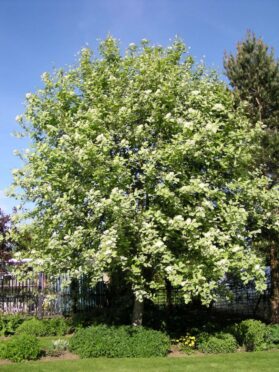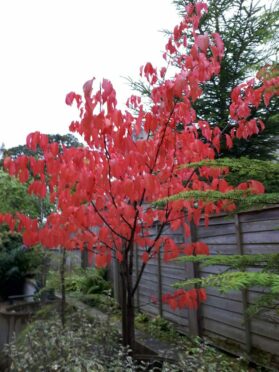Many of what we call sub-shrubs in our gardens come from the Mediterranean, Central Asia and China.
Phlomis fruticosa, better known as Jerusalem Sage, is a good example. These plants, in some areas, might need a bit of protection during the winter, but be careful, packing round the plant with straw might end with it rotting away at the neck – a very vulnerable area.
Given a wet winter with the surface soil being continuously saturated, the soft vegetative parts of the plant will rot through.
Answer? Be careful where you locate such plants at the outset and keep the surrounding soil loosened by light cultivation to encourage quick drainage.
For winter protection, any umbrella-type gadget is ideal simply to keep the rain off the base while allowing full aeration.
We do grow many plants from southern climes in our Scottish gardens, their ability to survive and delight us will often depend on good drainage and shelter from excessive wet. Hence as I say, there is a need to protect some plants umbrella-fashion, but they don’t necessarily need to be wrapped up.
On the other hand, Cordylines, Yuccas and some Phormiums do benefit from being wrapped up before winter sets in to prevent the winter rains lodging in the leaf axils where, combined with low winter temperatures, the leaf bases may start to rot.
With climate change, our winter weather will change slowly; it might be warmer but wetter. Let’s remember that Boy Scout motto – Be prepared.
Tree planting
As we approach the planting season for bare-root trees and shrubs, I was drawn to that lovely piece in the P&J a few days ago about the Scottish Tree Festival. Coincidentally, I received a cracking wee book as a birthday gift the week before called Heritage Trees of Scotland.
Simultaneously, we read much from scientists about the need to plant trees for carbon capture. They suggest planting, by the million, in open countryside. I can imagine that might encourage some “toonsers” to plant a tree or two in the garden – an excellent idea. There are two “buts” in that notion, however – consider the available space and the effect on neighbouring property. In other words, choice of tree will be crucial to the success of this ploy.
Example – Populus x candicans “Aurora” is a very handsome tree with beautiful variegated leaves. Once seen, I can imagine some folks would love to have one in the garden. I checked it out in a couple of reference books. One suggested that it must be planted at least 130ft from any buildings or drains. The other book quoted 60ft. How often do I say it – if you are inclined to plant a tree or two in your garden space, for goodness sake, do your homework.
I chose a poplar tree as my example because they are quite fast growing and we hear horror stories about poplars causing subsidence and subsequently serious damage being done to dwelling houses. There is no doubt that poplars have a greedy and extensive roots system, but the ultimate height of the tree can also cause problems.
Every species will have a maximum height potential to be taken in to account but most reported damage occurs on specific types of soil. On clays, for example, when the tree roots remove the moisture, the soil mass may actually shrink and that is what leads to subsidence.
Invasive greedy root systems will need to search for food and water. While they are unlikely to head for the house where the soil is drier, they would be drawn to drainage systems.
Poplars are certainly not suitable for small suburban gardens.
Some years ago, one of the major insurance companies, in conjunction with the arboricultural authorities, published a table of recommendations for tree planting, entitled: Trees – minimum safe distance from buildings – in metres.
Magnolia 5; Holly and Laurel 6; Spruce 7; Pine 8; Apple, Pear, Birch 10; Cherry, Plum, Rowan 11; Hawthorn 12; Walnut 14; Beech 15; Sycamore, Lime 17; Maple, Leyland 20; Ash 21; Plane 22; Horse Chestnut 23; Elm, Oak 25; Poplar 28; Willow 40.
These figures are a little too precise for my liking because I know that much will depend on soil type and depth, winter water table and other climatic factors. Even if I suggest that you take them “with a pinch of salt”, remember they are for guidance only. However, it does give you a rough idea of the planting distances required.
That is the spread of the root system dealt with but just as importantly – height, spread and density of the top growth can be equally troublesome.
Among my favourite trees for smaller gardens are Rowan, Crab Apples and some Flowering Cherries.




